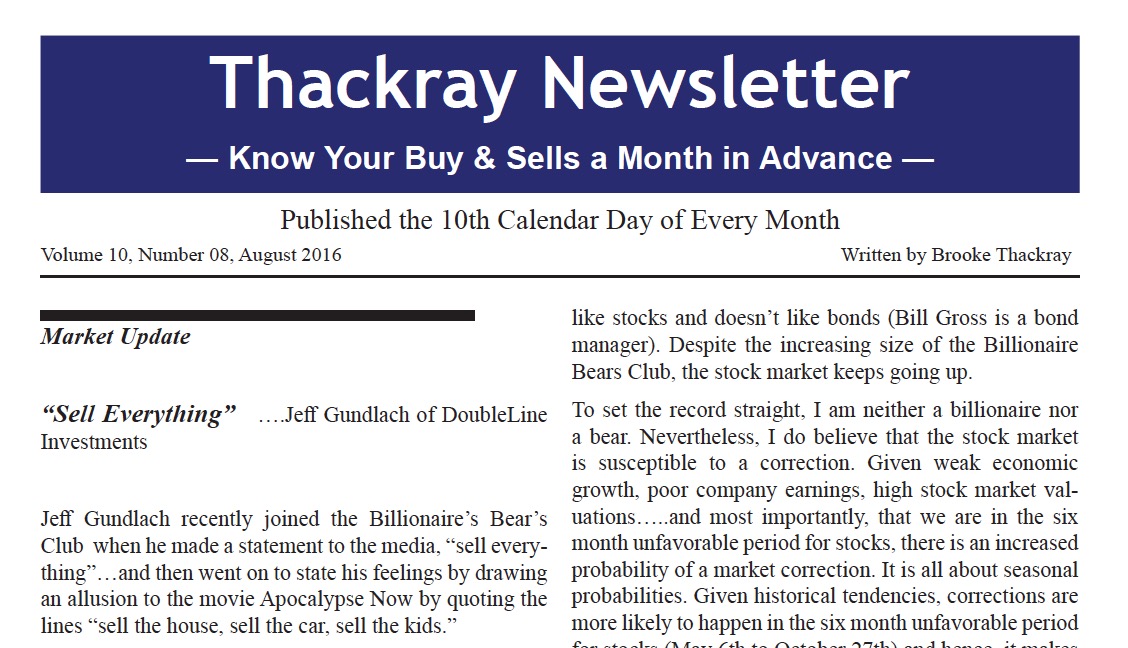Brooke Thackray: Market Update (August 2016)
by Brooke Thackray, alphaMountain Investments
"Sell Everything"
... Jeff Gundlach of DoubleLine Investments
Jeff Gundlach recently joined the Billionaire's Bear's Club when he made a statement to the media, "sell everything"... and then went on to state his feelings by drawing an allusion to the movie Apocalypse Now by quoting the lines "sell the house, sell the car, sell the kids."
Another billionaire bear was also recently added to the club when Bill Gross of Janus funds said that he doesn't like stocks and doesn't like bonds (Bill Gross is a bond manager). Despite the increasing size of the Billionaire Bears Club, the stock market keeps going up.
To set the record straight, I am neither a billionaire nor a bear. Nevertheless, I do believe that the stock market is susceptible to a correction. Given weak economic growth, poor company earnings, high stock market valuations ... and most importantly, that we are in the six month unfavorable period for stocks, there is an increased probability of a market correction. It is all about seasonal probabilities. Given historical tendencies, corrections are more likely to happen in the six month unfavorable period for stocks (May 6th to October 27th) and hence, it makes sense to be more conservative in the markets at this time.
Absolutely the stock market can continue to move up from here, but there is a seasonal risk in taking an aggressive position in the stock market in August and September. These two months have historically been the worst two contiguous months of the year. From 1950 to 2015, the S&P 500(R) has produced average losses in August and September of 0.1% and 0.5% respectively. In the same period, August has been positive 55% of the time and September 44% of the time.
At first blush, the numbers do not seem too bad: small average losses and gains occurring about half of the time. The problem is that from a seasonal perspective, investors are exposing themselves to excessive risk. Compared to the other months of the year, August and September have on average had fewer large rallies and more large corrections. It is not to say that in any one year, a large rally could not occur in August and September, but the long-term tendencies do not support such an outcome. If an investor had to refrain from being invested in the stock market for two months of the year, the choice would be easy: August and September.
Strong absolute performance in the unfavorable six month period for stocks (May 6th to October 27th), is rare and when it does occur, there has been a strong exogenous factor causing the anomaly. Using the threshold of a return of greater than 10%, the S&P 500(R) has only exceeded this level eight times in the unfavorable six month period for stocks since 1950. Five occurrences were the result of the economy growing strongly after a recession, two occurences were the result of economy moving from anemic growth to extremely strong growth i.e., the rally in the summer of 2002 was concurrent with the GDP moving from a growth rate of 0.3% in 2002 Q4 to 6.9% in 2003 Q3. The last occurrence of strong S&P 500 performance in summer months was the result of the introduction of QE in 2009. Currently the stock market may be rallying, but a super strong rally this summer does not fit the profile of past summer strong rallies.
Read/Download the complete report below:















